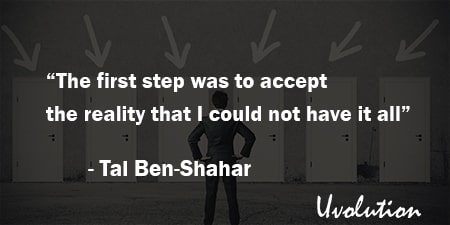The Pursuit of Perfect by Tal Ben-Shahar
The Book in 1 Sentences
Pursuit of Perfect: Stop Chasing Perfection and Find Your Path to Lasting Happiness!
“Perfectionism and optimalism are not distinct ways of being, an either-or choice, but rather they coexist in each person. And while we can move from perfectionism toward optimalism, we never fully leave perfectionism behind and never fully reach optimalism ahead. The optimalism ideal is not a distant shore to be reached but a distant star that guides us and can never be reached. As Carl Rogers pointed out, ‘The good life is a process, not a state of being. It is a direction, not a destination.” ~ Tal Ben-Shahar
5 BIG Ideas
1. Perfectionism VS. Optimalism!
2. Fail more often! It is only from the experience of challenging ourselves that we learn and grow.
3. Appreciate = to Be Thankful = Grow.
4. Change Thoughts = Change Emotions.
5. Love yourself first.
The Pursuit of Perfect Summary
“If the only dream we have is of a perfect life, we are doomed to disappointment since such dreams simply cannot come true in the real world.”
1. Perfectionism VS. Optimalism
“… psychologists today differentiate between positive perfectionism, which is adaptive and healthy, and negative perfectionism, which is maladaptive and neurotic.
I regard these two types of perfectionism as so dramatically different in both their underlying nature and their ramifications that I prefer to use entirely different terms to refer to them. Throughout this book, I will refer to negative perfectionism simply as perfectionism and to positive perfectionism as optimalism.”
“In essence, Perfectionists reject everything that deviates from their flawless, faultless ideal vision, and as a result they suffer whenever they do not meet their own unrealistic standards.
Optimalists accept, and make the best of, everything that life has to offer.”
Perfectionists and optimalists differ in how they deal with reality:
Optimalists accept and embrace the constraints of reality, while perfectionists reject those constraints.
And that makes perfectionists suffer from: “low self-esteem, eating disorders, sexual dysfunction, depression, anxiety, obsessive-compulsive disorder, psychosomatic disorders, chronic fatigue syndrome, alcoholism, social phobia, panic disorder, a paralyzing tendency to procrastination, and serious difficulties in relationships.”
Another difference is that “Optimalists tend to be benefit finders—the sort of people who find the silver lining in the dark cloud, who make lemonade out of lemons, who look on the bright side of life, and who do not fault writers for using too many cliches. With a knack for turning setbacks into opportunities, the Optimalist goes through life with an overall sense of optimism.”
“The emotional life that the Perfectionist expects is one of a constant high; the Optimalist expects his life to include emotional ups, emotional downs, and everything in between. The Perfectionist rejects painful emotions that do not meet his expectation of an unwavering flow of positive emotions; the Optimalist permits himself to experience the full range of human emotions.”
2. Fear of Failure
“One of the wishes that I always have for my students is that they should fail more often (although they are understandably not thrilled to hear me tell them so).
If they fail frequently, it means that they try frequently, that they put themselves on the line and challenge themselves.
It is only from the experience of challenging ourselves that we learn and grow, and we often develop and mature much more from our failures than from our successes. Moreover, when we put ourselves on the line, when we fall down and get up again, we become stronger and more resilient.”
“Those who understand that failure is inextricably linked with achievement are the ones who learn, grow, and ultimately do well. Learn to fail, or fail to learn.”
“Change is not a threat but a challenge; the unknown is not frightening but fascinating.”
“The pain associated with the fear of failure is usually more intense than the pain following an actual failure.”
“Paradoxically, our overall self-confidence and our belief in our own ability to deal with setbacks may be reinforced when we fail, because we realize that the beast we had always feared—is not as terrifying as we thought it was.”
3. Active Acceptance
“We all have an image of our ideal self, an elaborate construct of the kind of person we would like to be. While it is not always possible to feel as this constructed self would (fearless and compassionate at all times, for example), we can act in accordance with its ideals (courageous, generous, and so on).
Active acceptance is about recognizing things as they are and then choosing the course of action we deem appropriate and worthy of ourselves.
It is about recognizing that at every moment in our life we have a choice—to be afraid and yet to act courageously, to feel jealous and yet to act benevolently, to accept being human and act with humanity.”
“Taking the constraints of reality into consideration, the Optimalist then works toward creating not the perfect life but the best possible one.”
“The notion that we can enjoy unlimited success or live without emotional pain and failure may be an inspiring ideal, but it is not a principle by which to lead one’s life, since in the long run it leads to dissatisfaction and unhappiness.”
4. Appreciate = to Be Thankful = Grow
“The word appreciate has two meanings. The first meaning is ‘to be thankful,’ the opposite of taking something for granted.
The second meaning is ‘to increase in value’ (as money appreciates in the bank). Combined, these two meanings point to a truth that has been proved repeatedly in research on gratitude: when we appreciate the good in our lives, the good grows and we have more of it.
The opposite, sadly, is also true: when we fail to appreciate the good—when we take the good in our lives for granted—the good depreciates.”
5. Accept Reality
“Abraham Lincoln once jokingly asked, ‘How many legs does a dog have if you call the tail a leg?’ His answer? ‘Four. Calling a tail a leg doesn’t make it a leg.’”
“The first step was to accept the reality that I could not have it all. While it seems obvious that you cannot work fourteen hours a day and remain fit and healthy and be a devoted father and husband, in my perfectionist fantasy world, nothing was impossible.”
6. Psychological Injuries
“In the psychological realm, injuries come in the form of emotional harm; feeling lethargic, anxious, or depressed are some of the signals that we need some time to recover.
These signals, unlike physical injuries, are more subtle and easier to discount. And it is not uncommon for a person to continue working just as hard, if not harder, while the mind and the heart are pleading for a break.”
7. Recovery 3 Levels (Micro, Mid, and Macro)
“The problem in today’s corporate world, as well as in many other realms, is not hard work; the problem is insufficient recovery.”
“The rising levels of mental health problems, coupled with improved psychiatric medication, are thrusting us toward a brave new world. To reverse direction, rather than listening to advertisers who promise us the wonder drug, the magic pill that will improve performance and mood, we need to listen to our nature and rediscover its wonders.
Regular recovery, on the micro-, mid-, and macrolevels, can often do the work of psychiatric medicine, only naturally.”
So, how can we do that kind of recovery?!
Micro-level recovery: Take a 15-minute break every hour or two.
Mid-level recovery: Sleep for a seven to nine hour every day + one day off per week.
Macro-level recovery: Take a two to four week break every year.
8. Change Thoughts = Change Emotions
“The basic premise of cognitive therapy is that we react to our interpretation of events rather than directly to the events themselves, which is why the same event may elicit radically different responses from different people.
An event leads to a thought (an interpretation of the event), and the thought in turn evokes an emotion. I see a baby (event), recognize her as my daughter (thought), and feel love (emotion). I see the audience waiting for my lecture (event), interpret it as threatening (thought), and experience anxiety (emotion).”
Tal continues: “The goal of cognitive therapy is to restore a sense of realism by getting rid of distorted thinking.
When we identify an irrational thought (a cognitive distortion), we change the way we think about an event and thereby change the way we feel.
For example, if I experience paralyzing anxiety before a job interview, I can evaluate the thought that elicits the anxiety (if I am rejected, it will all be over and I will never find a job) and reinterpret the event by disputing and replacing the distorted evaluation with a rational one (although I really want this job, there are many other desirable jobs out there).
The distortion elicits an intense and unhealthy fear of failure; the rational thought reframes the situation and puts it in perspective.”
9. The Platinum Rule
“Why the double standard, the generosity toward our neighbor and the miserliness where we ourselves are concerned? And so I propose that we add a new rule, which we can call the Platinum Rule, to our moral code: ‘Do not do unto yourself what you would not do unto others.’”
“To say ‘I love you’ one must know first how to say the ‘I’.”
“When the Dalai Lama was then asked to clarify whether indeed the object of compassion may be the self, he responded: ‘Yourself first, and then in a more advanced way the aspiration will embrace others. In a way, high levels of compassion are nothing but an advanced state of that self-interest. That’s why it is hard for people who have a strong sense of self-hatred to have genuine compassion toward others. There is no anchor, no basis to start from.’”
That was my QUICK The Pursuit of Perfect summary. If you’re interested, get your copy. There is a HUGE amount of wisdom and life-changing ideas in this book, and we’ve only touched on a tiny bit of it.
Buy The Book: The Pursuit of Perfect by Tal Ben-Shahar

GET Blinkist 7 Days FREE Trial
3000+ Book Summaries
(Audio and Text)





